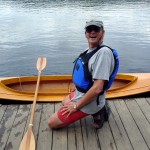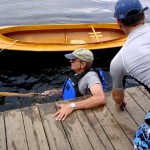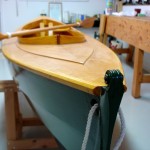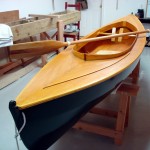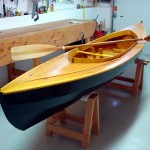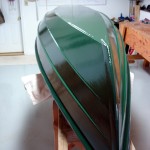Eva, my best friend and partner of 45+ years, won the naming contest. I was, of course, planning to name the boat after her. Since I am planning on building two boats, one for each of us, in my traditionalist fuddy duddy way I intended to name them “Eva I” and “Eva II.” She’s a linguist, perpetual language student, and language teacher. She did a little word play to turn those into “Eva Won” and “Eva Too.”
Today’s launch was at a Lake Sebago, in the Palisades Interstate Park near where we live. The lake is too small for power boats and just right for canoes and occasional competitive rowing and sailing events. Transport to the lake is atop the lumber rack on my truck. It’s a short walk / carry to the small launch dock. Putting in was a piece of cake. Getting underway was a different story. You ought to hear Eva laugh at the sequence of these next two pictures.
I was so busy talking (about the boat, of course) to the guy with the blue hat that I wasn’t careful enough in entering the boat. Swim around to a shallow area, climb out, and try again. The next time went better, after we pumped out about a gallon of water. THANKS to another bystander who had a nifty hand pump. (Gotta get one of those.)
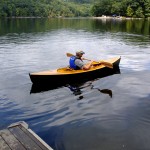 Yes, the boat is tippy, but no more so than a white water kayak. Actually, probably a little bit less. Once situated, I felt no uneasiness at all. The boat rows easily. It was not at all difficult to put on some comfortable speed. It tracks well. Perhaps it could turn more easily, but that could also be due to my novice rowing technique. It seems to be quite watertight, except when you submerge one side when trying to enter. Water in the boat came from two sources, submerging the port side on the first entry attempt, and from the paddle. The drip rings on the paddle helped, but need to be improved. After returning home, I checked the watertight compartments and found them bone dry.
Yes, the boat is tippy, but no more so than a white water kayak. Actually, probably a little bit less. Once situated, I felt no uneasiness at all. The boat rows easily. It was not at all difficult to put on some comfortable speed. It tracks well. Perhaps it could turn more easily, but that could also be due to my novice rowing technique. It seems to be quite watertight, except when you submerge one side when trying to enter. Water in the boat came from two sources, submerging the port side on the first entry attempt, and from the paddle. The drip rings on the paddle helped, but need to be improved. After returning home, I checked the watertight compartments and found them bone dry.
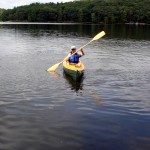 The paddle worked well too. The paddle itself taught me how to use it. Once I found a good technique, the paddle became absolutely silent in the catch and almost silent in the exit. The paddle’s length (90.5 inches, 230 cm) was determined by the length of lumber I purchased. I think it could stand to be 6 to 8 inches longer. I found myself reaching outside that imaginary box formed by shoulders and elbows to get enough paddle immersion.
The paddle worked well too. The paddle itself taught me how to use it. Once I found a good technique, the paddle became absolutely silent in the catch and almost silent in the exit. The paddle’s length (90.5 inches, 230 cm) was determined by the length of lumber I purchased. I think it could stand to be 6 to 8 inches longer. I found myself reaching outside that imaginary box formed by shoulders and elbows to get enough paddle immersion.
It was a very fine launch day, and a good time was had by all … especially the spectators at the dock. Now, I know why many advise “never paddle alone.” You need someone, not to hold the boat while you enter, but to laugh at the harmless mishaps (and to help carry – THANKS Eva!).
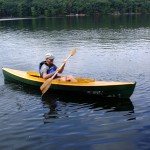 Ready to float, the boat weighs 51 pounds. It’s an easy weight to load and carry and only 5 pounds heavier than the designer’s estimate. A fellow who had just carried his Coleman 15.5 canoe (listed at 76 pounds) lifted mine and smiled at how light it is. I think mine is heaver than what Harry specified because I avoided making the scantlings too scant. I erred on the fat side when thickness planing the planking material. The one area where I erred on the thinner side was the coamings. If you look closely at the second picture, you can see that the port side coaming became a casualty to my clumsy first entry. It cracked when brushing the side of the dock as that side submerged. It will be easily repaired.
Ready to float, the boat weighs 51 pounds. It’s an easy weight to load and carry and only 5 pounds heavier than the designer’s estimate. A fellow who had just carried his Coleman 15.5 canoe (listed at 76 pounds) lifted mine and smiled at how light it is. I think mine is heaver than what Harry specified because I avoided making the scantlings too scant. I erred on the fat side when thickness planing the planking material. The one area where I erred on the thinner side was the coamings. If you look closely at the second picture, you can see that the port side coaming became a casualty to my clumsy first entry. It cracked when brushing the side of the dock as that side submerged. It will be easily repaired.
Back to the boat’s name. There are no name banners on the boat yet. I tried creating waterslide decals, but found that inkjet inks just aren’t opaque enough for this application. (I wanted yellow lettering on the green hull.) We’ll try another approach soon.
Eva’s still laughing at the first two pictures.
